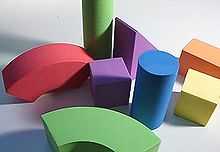Toy block

Toy blocks (also building bricks, building blocks, or simply blocks), are wooden, plastic or foam pieces of various shapes (square, cylinder, arch, triangle, etc.) and colors that are used as construction toys. Sometimes toy blocks depict letters of the alphabet.
History

1693: One of the first references to Alphabet Nursery Blocks was made by English philosopher John Locke, in 1693, made the statement that "dice and playthings, with letters on them to teach children the alphabet by playing" would make learning to read a more enjoyable experience.
1798: Witold Rybczynski has found that the earliest mention of building bricks for children appears in Maria and R.L. Edgeworth's Practical Education (1798). Called "rational toys," blocks were intended to teach children about gravity and physics, as well as spatial relationships that allow them to see how many different parts become a whole.[1]
1820: The first large-scale production of blocks was in the Williamsburg area of Brooklyn by S. L. Hill, who patented "ornamenting wood" a patent related to painting or coloring a block surface prior to the embossing process and then adding another color after the embossing to have multi-colored blocks.
1837: Friedrich Fröbel invent a preschool educational institution Kindergarten. For that he design ten Froebel Gifts based on building blocks principles.
1850: During the mid-nineteenth century, Henry Cole (under the pseudonym of Felix Summerly) wrote a series of children’s books. Cole's A book of stories from The Home Treasury included a box of terracotta toy blocks and, in the accompanying pamphlet "Architectural Pastime.", actual blueprints.
2003: National Toy Hall of Fame at the Strong Museum, inducted ABC blocks into their collection, granting it the title of one of America's toys of national significance.
Educational benefits
- Physical benefits: toy blocks build strength in a child's fingers and hands, and improve eye-hand coordination. They also help educate children in different shapes.
- Social benefits: block play encourages children to make friends and cooperate, and is often one of the first experiences a child has playing with others. Blocks are a benefit for the children because they encourage interaction and imagination. Creativity can be a combined action that is important for social play.
- Intellectual benefits: children can potentially develop their vocabularies as they learn to describe sizes, shapes, and positions. Math skills are developed through the process of grouping, adding, and subtracting, particularly with standardized blocks, such as unit blocks. Experiences with gravity, balance, and geometry learned from toy blocks also provide intellectual stimulation.
- Creative benefits: children receive creative stimulation by making their own designs with blocks.
Notable types and brands
- Unit block is a popular standardized wooden toy block.
- Kapla and KEVA Planks are wooden block construction toys.
- LEGO is a line of popular plastic building toys.
- Lincoln Logs is a toy consisting of notched miniature logs.
- Stickle bricks is a plastic construction toy primarily intended for toddlers.
- Froebel Gifts are a range of educational materials first used in the original Kindergarten.
- Montessori sensorial materials are a range of educational materials including wooden blocks.
- Tinkertoys consists of rods and wheels.
| Wikimedia Commons has media related to Category:Toy blocks. |
References
- ↑ Witold Rybczynski, Looking Around: A Journey Through Architecture, 2006